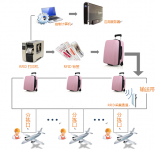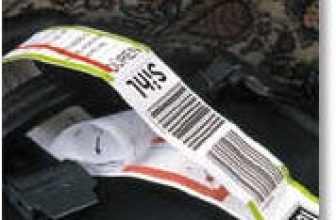
Application of UHF RFID in Airport Baggage Automatic Sorting System
[ad_1]
With the continuous deepening of the domestic economic reform and opening up, the domestic civil aviation industry has achieved unprecedented development. The number of passengers entering and leaving the airport continues to increase, and the luggage throughput has reached a new height. The handling of baggage has always been a huge and complicated task for large airports. In particular, the ongoing terrorist attacks against the aviation industry also put forward higher requirements for baggage identification and tracking technology. How to manage piles of luggage and effectively improve handling efficiency is an important issue faced by airlines.
1. Background
In order to cope with the new challenges that passenger baggage poses to the processing capacity of the airport conveying system, Xinwangcheng UHF RFID read-write modules and UHF RFID read-write devices have been used in automatic baggage sorting systems in more and more airports. This system uses barcode labels to identify passenger luggage. During the transportation process, it achieves the sorting process of passenger luggage by identifying the barcode. The baggage tracking system of global airlines has developed to the present and is relatively mature. However, even under the most ideal conditions, the barcode system can only correctly read 8 to 9 pieces of baggage, which means that airlines have to Continuously invest a lot of time and energy in manual operations to transport the sorted baggage to different flights. At the same time, because bar code scanning requires high directionality, this also adds extra workload to airport staff when performing bar code packaging.
Simply using barcodes to match and sort luggage will be a task that requires a lot of time and energy, and may even cause serious flight delays.
Improving the degree of automation and sorting accuracy of the airport baggage automatic sorting system is of great significance to protect public travel safety, reduce the work intensity of airport sorting personnel, and improve the overall operating efficiency of the airport.
RFID radio frequency identification technology is generally regarded as one of the most promising technologies in the 21st century. It is a new technology that has caused changes in the field of automatic identification after barcode technology. Its non-line-of-sight, long-distance, low directivity, fast and accurate wireless communication capabilities have been increasingly focused on the airport baggage automatic sorting system. Finally, in October 2005, IATA (International Air Transport Association) unanimously passed a resolution to adopt UHF (ultra-high frequency) RFID strap-on tags as the only standard for aviation luggage tags.
2. System Architecture
The RFID baggage automatic sorting system is to paste RFID electronic tags on the randomly checked baggage of each airplane passenger. The electronic tags record the passenger’s personal information, departure port, arrival port, flight number, parking position, departure time and other information; baggage flow Electronic tag reading and writing equipment is installed on each control node of the, such as the sorting, loading area, and baggage claim area. When the baggage with tag information passes through each node, the RFID reader will read the information and send it to the database. Realize the information sharing and monitoring of baggage in the whole transportation process. The system architecture diagram is as follows:

Figure 1 RFID baggage automatic sorting system architecture
3. System flow
Passengers departing from the airport check their baggage at the departure check-in counter. The staff completes the check-in registration and prints the RFID baggage tag according to the passenger boarding pass, installs the RFID baggage tag on the baggage and puts it on the baggage conveyor. The conveyor is equipped with an RFID collection channel. When the baggage passes through the RFID collection channel, its related information is collected and uploaded to the conveyor control system. The conveyor control system can sort the baggage correctly to the corresponding flight based on the obtained information. The luggage room is not well. Finally, the porter transfers the baggage of the corresponding flight to the luggage compartment, and enters the cargo hold of the plane with the tractor.

Figure 2 Baggage automatic sorting system
The automatic baggage sorting system at the airport uses RFID technology, which uses electronic tags to identify baggage and uses radio frequency signals to automatically identify the target baggage. Even multiple high-speed moving baggage objects can be simultaneously identified without manual intervention, and the operation is quick and convenient. The mechanization rate of RFID technology can reach more than 95%, which means that technically, the possibility of baggage loss, late delivery, and wrong delivery will be greatly reduced. At the same time, RFID can work in a variety of harsh environments. In this way, the luggage safety of passengers can be strengthened, and the error rate and other problems can be greatly reduced.
In addition, each RFID reader can be connected to the server through the network, and it can effectively record, track and monitor from all aspects of baggage check to the final delivery of the luggage. The entire process can be grasped in time, and the management is performed dynamically. Based on this statistical data and checking the situation of each link, targeted management can be achieved, and the information and intelligence of airport baggage management can be improved as a whole.
4. System key technology
The air baggage automatic sorting system should aim to achieve maximum efficiency, safety, reliability, and ease of maintenance. In the entire system, RFID data collection is particularly critical.
High-speed data collection
In order to meet the increasing number of passenger luggage at airports, especially in large and medium-sized airports, the conveying speed of conveyors is increasing. Higher transmission speeds have higher requirements for the collection speed of RFID readers;
stability
The automatic baggage sorting system of aviation and airport operates continuously 24 hours a day, 365 days a year, and RFID equipment must meet the stable operation in this environment.
reliability
The baggage sorting system must accurately obtain the information of each piece of baggage in order to correctly complete the sorting, which requires the RFID equipment to have very high reliability and accurately collect the information of each piece of baggage;
compatibility
The core control part of automatic baggage sorting system generally adopts PLC. In order to achieve the purpose of high-speed and accurate sorting, how the PLC can obtain the data collected by the RFID device is also very important, which also requires that the RFID device must be compatible with the PLC. RFID devices that support instruction set control can be well compatible with PLC.
5. Product selection
According to the requirements of the airport baggage automatic sorting system for RFID equipment, the system equipment selection adopts an integrated UHF RFID reader.

Xinwangcheng UHF RFID equipment has a high-speed reading capability of 750 tags/s, which can adapt to the normal reading under the scenario of 180Km/h per hour, and meet the requirements of the airport baggage automatic sorting system for the data collection speed. The four-channel reader of Xinwangcheng can connect up to 4 antennas to work at the same time, which has a wider coverage and can read luggage tags from multiple angles, which greatly improves reliability. At the same time, it has super anti-interference ability and can adapt to various harsh industrial environments. The dual optimization of good power consumption and heat dissipation can ensure the long-term continuous power and stable operation of the equipment, which is suitable for the stability requirements of the airport baggage sorting system.
[ad_2]





